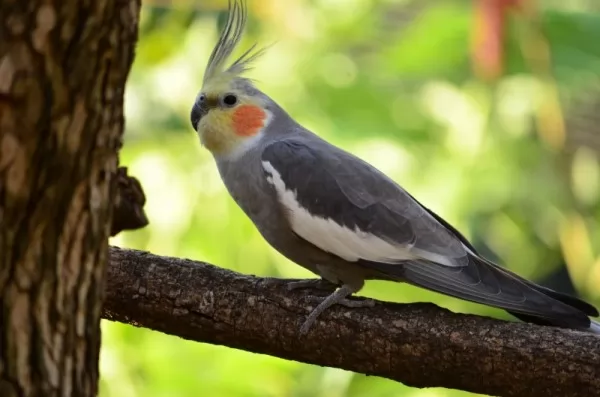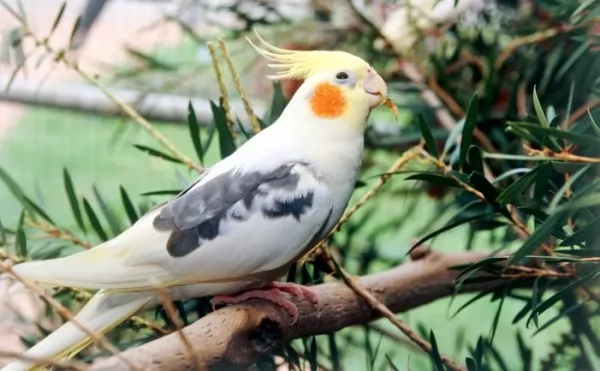Cockatiel parrots are one of the most popular pet birds, and the cockatiel is considered one of the affectionate and intelligent birds, and Europeans have returned to their homeland from Australia with these adorable little birds, and there are a variety of hybrid cocktail parrots to choose from, and you will find that these little birds are cute and compete in Get the title of the best pet bird with the Australian Dora's Parrot and some Canary Breeds.
Cockatiel parrots have so many positive qualities as pet birds, it is hard to know which are the most important characteristics. They are low cost, strong, clean, intelligent, gentle, loving, playful, calm, adaptable, tolerant, easily trained, breed easily, The list is many, and they can often learn to talk, especially males, and can easily learn all kinds of tricks, and cockatiel parrots are one of the 52 species of parrots indigenous to Australia.
Bird characteristics:
Cockatiel parrots behaviors:
Cocktail parrots because of their intelligence and the strength of their personalities, they are very close to each other, and by observing these birds, they are a good choice for children, because of their gentle behavior, and parrots are less prone to nervousness and psychological disorders, and males and females of parrots are friendly and gentle, and sometimes controlled by other pet birds such as Australian Durra Parrot, and love birds, so you must take care of it well if you keep it with other birds.
*Tame Cocktail:
When you want to tame and train cockatiel parrots, it is best to choose modern parrots.
Cocktail training:
Training all birds starts with confidence, and takes a little preparation, but it takes patience.
Quick tips when training a cocktail:
* Cut some feathers from the parrot's wings to reduce the chance of escape.
* Work in a small room while minimizing disturbances.
* Do several short exercises each day with the parrot, each lasting 20 minutes.
* Speak softly and move slowly.
* Parrot reward is a necessary thing.
* If your parrot bites, you can start training it by standing on the stick first, then your finger.
When the parrot learns basic behaviors from you, it can start with more advanced tricks.
* Make sure the birds mingle with other people so that they do not become too attached to only their trainer.
Cockatiels are high-pitched voices, and they are not the best talking birds, but they can learn some words with patience and repetition, and cockatiel males learn to speak faster than females.
Cockatiel parrots:
1- Natural cocktail:
* gray cocktail
2- The hybrid cocktail:
The spotted cockatiel, which has white and yellow spots on the body, lacks black pigment.
* Latino Cocktail, and usually lacks black pigment, and the female usually becomes brighter than the males.
* Pearl cockatiels have white and yellow plumage with a gray border.
* Cinnamon cocktail, as the black dye turned into the brown dye.
The cockatiel is silver, and its color is pale gray due to a partial decrease in the black pigment, and it also has redness in the eyes and beak, and the feet are pink.
Care and feeding:
Bird food:
A commercial seed mixture for cocktail parrots is suitable along with supplemental vitamins. Parrots can supplement their diet with green foods such as dandelion leaves, carrot tops, celery, watercress, spinach, peas, herbs, and millet. They should also enjoy eating various fruits. Like apples, oranges, bananas, etc., squid bones are recommended to help provide calcium, and proteins can be offered in the form of enamel pellets, dog food, and even boiled and mashed eggs.
- water :
Cocktail parrot should be given fresh drinking water every day, and you can also add vitamins and minerals dissolved in the water.
- Shower :
You can put a plate of water at the bottom of the cage to bathe the bird.
- Garnish:
Care includes keeping the wings clipped, this will prevent the bird from escaping, and providing branches from new trees and shrubs such as oaks, maples, and fruit trees help the birds in climbing, chewing, and trimming the beak and nails.
The dwelling:
- bird cage :
Cockatiel parrots love a spacious cage, so the cage of a cockatiel must be at least wide enough so that the parrot spreads its wings without touching the sides, and this is at least about (45 x 45 x 60), and cages must be metal anti-chew, as the Cocktail parrots are easy to destroy wooden cages, the cage should have horizontal bars on the sides because the bird likes to climb, and put a light skirt on the sides to prevent seeding, and the bottom of the cage can be covered with paper, pebbles and sand.
- Bird perch:
Provide one or two 3/4 inch diameter bird perches, and place dishes away from the perches so that they do not contaminate parrot droppings, and do not use plastic because parrots are able to break plastic and can become dangerous.
- Cocktail parrot cage location:
Putting the cage in an area away from sudden temperatures, placing it at eye level or a little higher, which makes the birds feel safe, and covering the cage at night is not necessary, but it will help keep the birds calm and give them a greater sense of safety.
Maintenance:
Basic cage maintenance includes daily cleaning of food and water dishes, changing the paper at the bottom of the cage every 2-3 days, cleaning and sterilizing the cage weekly, washing and drying the perches and toys when they become dirty, and the sand floors in the cages must be renewed annually.
Social behaviors:
Cockatiel parrots are very domesticated birds, friendly to people, as well as other birds, and in the wild parrots live in groups of 12 parrots, although they flock by the hundreds after the breeding season, and where food is abundant, and accordingly it can mix well with other small birds Other than parrots, they love attention and handling.
Reproduction:
Cocktail parrots are among the easiest birds that breed in captivity, and in the wild, pairs of parrots build their nests in tree cavities at a height of 6 meters from the surface of the earth, and the appropriate cage for breaking in captivity should be at least (90 x 120 x 120) cm, and the nest box has an area Approximately (30 x 40 x 30) cm, which is lined with sawdust or pine.
The appropriate age for breeding in cockatiels is 18 months to two years, and you must bear in mind that the cockatiel can be aggressive during the breeding period, which can take from (4-6) weeks, and the female lays one egg per day, which may reach between ( 3- 9) eggs, the incubation period is between (18-20) days, and the young will begin to leave the nest from (5-6) weeks, and they will be completely independent two weeks after leaving the nest.
Health problems :
Cockatiel health is easy to maintain, however, there are signs of illness that you should be aware of, such as lack of activity, falling feathers, or if they show any signs of weight loss (weight loss can be rapid and fatal).
Some diseases and injuries of your pet are broken wings or legs, open wounds, beaks and ingrown nails, sore feet, feather abscesses, weight loss, stroke, shock, tremors, egg retention, indigestion, eye diseases, mites, watery eyes , colds, tumors, psittacosis, coccidiosis, goiter, E. coli, aspergillosis, conjunctivitis, constipation, diarrhea, arthritis and rheumatism.
Preparing your cage is very important during illness, covering all sides and adding a bulb or light heating, maintaining a constant temperature around 70 degrees Fahrenheit, removing all perches and placing food and water dishes on the floor. If you don't see any improvements within a few hours, you should You take the sick parrot to the vet for diagnosis and treatment.
How to train and care for a cockatiel




0 Comments